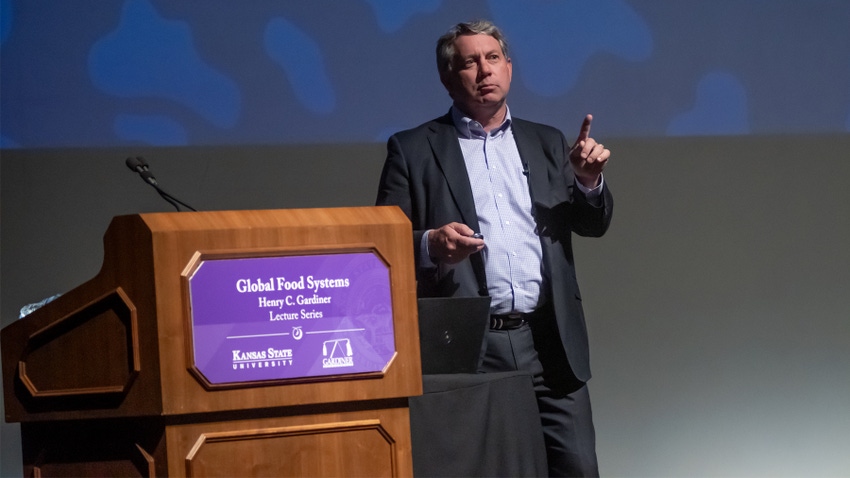
American agriculture is poised for enormous opportunities in the global marketplace — but only if farmers and ranchers adopt a mindset to adapt and innovate quickly to meet the demand, says Gregg Doud, CEO of the National Milk Producers Federation.
Doud shared his geopolitical food and ag insights Oct. 9 in his Henry C. Gardiner Global Food Systems Lecture at Kansas State University. His career experience in the global food arena has taken him from his boyhood home in Mankato, Kan., to working for U.S. Wheat Associates and the National Cattlemen’s Beef Association, to serving as U.S. ambassador and chief agricultural negotiator in the Office of the U.S. Trade Representative. Today he is the CEO and president of the National Milk Producers Federation.
The China in the room
“What happens in China in terms of food dictates everything else in the rest of the world,” Doud said. In 2022, China imported $236 billion in agricultural commodities, while the U.S. exported $196 million, he said. He noted several key trends that U.S. farmers should pay attention to:
Hog production. China produces nearly half of the world’s hogs in massive 20-story-high, farrow-to-finish facilities that rival high rise hotels and can house 100,000 sows. In 2020, the Chinese government banned feeding swill, causing a boom in corn imports overnight. Today, China is the biggest corn importer on Earth, at $10.46 billion in imports this year. For the first time, China has reached out to Brazil to meet its corn demand, Doud said, because of the war in Ukraine and because they didn’t want to be beholden to the U.S.
Taste for beef. Young people in China have a taste for beef, and the country is cleaning the world out of it, Doud said. The country imported about 150,000 metric tons of it in July, nearly a record high. In his negotiations with the Chinese as ambassador, Doud said they were mostly concerned with the safety and traceability of the beef they purchase. Easing their concerns is how the U.S. sold China $2.1 billion in U.S. beef last year, he said.
Fertilizer monopoly. The BRIC countries — Brazil, Russia, India and China — dominate global food production, Doud said. On the fertilizer side, they are enormous competitors for nitrogen, phosphorus and potash, which could pose a problem for U.S. farmers if they every decide to collude, he warned.
Changing soybean focus
The rise of renewable diesel’s popularity, as well as Brazil’s emerging production boom, is poised to change the way we look at the soybean market opportunities of the future, Doud said.
If Brazil can raise one crop of corn and soybeans on the same ground every year, that timing of when they go to market is a problem for U.S. soybeans to compete, Doud explained.
They have seasonality, better-quality soybeans, and a freight advantage over the U.S., according to Doud.
“Here’s the question that we have to ask ourselves,” he said. “How sustainable is that? How hard can they push that land down there and continue to do that year after year? You’re going to begin to see a little yield drag.”
And yet, the news isn’t all bad for U.S. soybean farmers. Rising demand for soybean oil for production of renewable diesel due to government mandates means that for the first time in history, the U.S. will be using more soybean oil for renewable diesel than we are for food, Doud said.
“We are going to have a mountain of soybean meal — to a point where I had a conversation the other day about soybean meal pricing at $150 a ton,” Doud said. So, if competing against Brazil in exporting soybeans isn’t ideal, the U.S. could feed that soybean meal to more hogs and poultry and export the protein to regions that cannot meet their domestic demand.
Protein demand
“In no way, shape or form does the supply of animal protein in the world come anywhere near meeting the demand,” Doud said. “And if you look around the world, what do you see? Who else in the world can make more animal protein [than the U.S]?” Europe’s push for a farm-to-fork system that throttles back its farm production won’t meet the demand, he explained. America has the knowledge, the technology, and the resources to raise cattle, hogs and poultry and produce dairy.
Doud pointed out that Manhattan, Kan., is the epicenter of opportunity in the animal agriculture sector —with the National Bio and Agro Defense Facility next door to one of the best veterinarian schools in the country, and right along the animal health corridor. There’s a record $53 billion in venture capital being invested in technology that will help farmers grow more crops and healthier livestock, and yet our government regulations stand in the way, he said.
“The technology that we have coming in agriculture is unbelievable,” Doud said: from finding a similar molecule to glyphosate in the mint plant, to see-and-spray weed control in equipment, to autonomous transportation and robots in dairies. And yet, we can’t get government approval for some of this technology in a time frame that provides a return on investment for these innovators, and that further delays our growth, he said.
“This is a holdup for our country,” he said. “We have got to get our government to the point where they approve this technology, so we can move forward.”
The changing global marketplace is going to require an American farmer of tomorrow who can adapt and innovate, and be flexible to change when the market changes, Doud told the audience.
“If you don’t have this mindset in agriculture, you’re not going to make it,” Doud said. “You have to be able to adapt and innovate and be willing to use technology.”
About the Author(s)
You May Also Like






